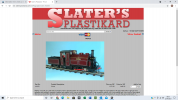Well, the objective of this thread was to get some UK opinions on this situation - we achieved that.

I started making my own track in the 1950s, and continued sporadically until about 10 years ago, when I ended up in living in an apartment with no layout. Garden Railway Magazine even published an article I wrote about how to make your own points/switches. So I have wrestled with the problem of finescale wheels versus coarse commercial wheels in many scales over the years.
The fact is that if you want wheels with different back-to-back measurements to go through your frog, you need to make the check rail gap small and the frog gap wide. That way your finescale wheels don't pick the frog, and the coarse wheels have room to get through the wide gap at the frog. However, both will drop in to the gap, a problem that LGB solved by putting a runway in the gap for the wheels to run on.
Adding a brass strip along the check rail of an LGB point/switch is a well-known solution if you have non-LGB slightly nicer wheels. (Accucraft come to mind.) However, it doesn't help the LGB wheels - they may bounce over the check or frog guard rails. If you only have 2 different types of wheels, you may be able to get the strip to work for you.
Interestingly, my pal has since tried the "add a washer" solution. I explained why he was seeing derailments with axle hub washers to make the wheels rest on the rails, and he found some larger washers. Note the brass washers to push the wheels further out on the axle, and the outer washer to reduce the back-to-back again.
Unfortunately, even though he now had wheels with a similar back-to-back as the LGB, his flanges are so fine that it still derails on anything other than perfect track.
If you want to read the rest of his saga it is on LSC:
Large Scale Central - Advanced Forum Detail Topic - Request Opinion -- Smallbrook Studio Motor Block
A final note (final for me as I think we've flushed out the issues and thoroughly discussed them.) I did hear from Slaters, and I also had an email from Michael, Mr Smallbrook Studios, both of whom I have done business with in the past, and both companies I completely recommend. Michael did say the 5mm Slaters wheels work fine on 32mm track, but he thought he might be among the first vendor to try finescale 32mm wheels on 45mm gauge axles, and he had heard similar comments from other customers.
My opinion is that the 'Small England' Sm32 wheels are just too fine to use on 45mm LGB track. What is needed is some gauge-3 type wheels with 7mm width and larger flanges. Unfortunately, Slaters doesn't make anything with coupling rods that will fit the Smallbrook chassis.



